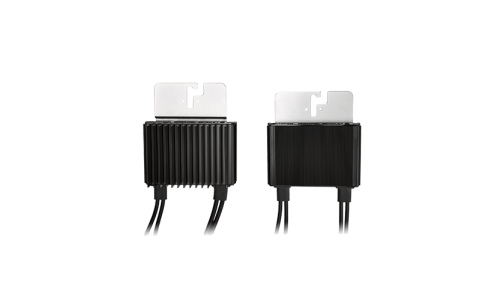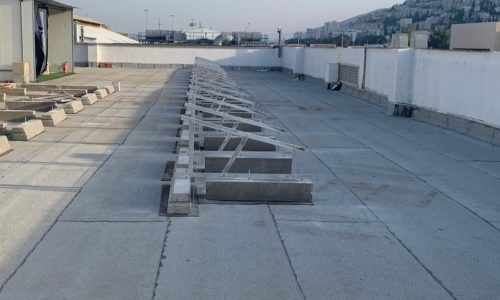For every solar array, whether residential or commercial, you need a custom-designed racking system to fit the panel layout to the contours of the roof and the desired angle and azimuth of the panels. The racking system is built from two main components: the “legs,” which give the racking its height and angle, and the “rails” on which the panels are installed. There are different ways to combine these elements for each roof type.
Legs
The legs of the system are built from modular aluminum elements cut to size based on the construction engineer’s specifications. The bars of aluminum are assembled and connected with galvanized bolts and nuts to build the trapezoidal shape of the legs as per the engineer’s design. The legs are bolted to concrete ballasts or drilled directly into the roof with the appropriate screws based on the roof type.
Rails
The square aluminum profiles that make up the rails are molded with special dyes to fit the specially designed fasteners that hold the panels in place. For a secure installation, the rails are connected to the legs with galvanized bolts and nuts.
The connection between the racking and the roof varies based on the roof type.
Concrete roof
On concrete roofs, the racking not only holds our panels in place but also determines the height and angle of the panels, allowing us to optimize the output of your solar array. As previously mentioned, the aluminum racking is bolted to concrete ballasts to prevent any need to damage the roof’s water-proofing. In the case of an uneven roof, our teams employ special “arrow-bolts” that allow installers to adjust the height of each bolt as necessary and keep the system flush.
Panel Roof
The racking for panel roofs is nearly identical to a concrete roof. The main difference is how the legs are connected to the roof. We need to drill through the roof itself on panel roofs and connect it directly to the structural beams. The exact type of screw and technique can vary from project to project, but as laid out in our first article about building a solar array, our team puts a particular emphasis on water-proofing.
Tile Roofs
The use of legs on tile roofs is not legal in Israel, and the panels are always installed parallel to the roof. As detailed in our first article, “hooks” are connected to the roof’s support beams, and the rails are bolted to the hooks the same way they would be connected to the legs. Hooks raise the panels by 15-25 cm, depending on the roof’s requirements, and allow for a faster installation than one that includes building legs.
Points of Emphasis
The whole point of a sound racking system is that it will hold the panels in place without any issues for 25 years or more. At Kedma, we emphasize a few technical points when designing any racking system plan:
- Wind Tunnels – If a given roof is in an area with heavy weather, we will reinforce the racking with more support beams and ballasts as necessary.
- Obstruction Heights – To minimize shading, our plan accounts for the height of other elements on the roof, such as railings, AC units, and vents.
- Weak Points—Most tile and concrete roofs can hold a half-ton or more of weight at any given point. However, pergolas and some panel roofs have weak points that are not suitable for installation. Our civil engineer checks each roof for weak points and can provide plans and contractors to strengthen the roof as necessary.
No matter the roof type, any professional and qualified installer can provide a tailor-made solution that will provide a reliable and sturdy base for your system. At Kedma, we ensure that every system is reviewed by our civil engineer before installation and make every effort to optimize the racking system to maximize solar output.
Interested in installing a solar system on your roof? Contact us today!


